Zhu Song, thank you very much for your input! Your comments brought me to the right track.
Well, I did not follow strictly your text, but I found new stuff to read.
I want the controller to be part of my application as well. So, what I did is roughly the following:
- Prepare EVENT_TRACE_PROPERTIES structure
- TraceLogRegister
- StartTrace
- EnableTraceEx2 (enable)
- TraceLoggingWrite
- TraceLoggingUnregister
- EnableTraceEx2 (disable)
- ControlTrace (stop)
This resulted in an xxx.etl file that I could view with tracerpt or WPA.
Thanks again! I'm all fine now.
This is the code in detail:
#include <windows.h> // or <wdm.h> for kernel-mode.
#include <winmeta.h>
#include <TraceLoggingProvider.h>
#include <evntrace.h>
#include <stdio.h>
#include <strsafe.h>
#define LOGFILE_NAME TEXT(".\\Test-Test.etl")
#define LOGSESSION_NAME TEXT("Test-Test-Session")
// Define the GUID to use in TraceLoggingRegister
// {5B5852D4-DC24-4A0F-87B6-9115AE9D2768}
TRACELOGGING_DEFINE_PROVIDER ( // defines g_hProvider
g_hProvider, // Name of the provider variable
"Test-Test", // Human-readable name of the provider
(0x5b5852d4, 0xdc24, 0x4a0f, 0x87, 0xb6, 0x91, 0x15, 0xae, 0x9d, 0x27, 0x68) ); // Provider GUID
static const GUID ProviderGUID = { 0x5b5852d4, 0xdc24, 0x4a0f, {0x87, 0xb6, 0x91, 0x15, 0xae, 0x9d, 0x27, 0x68} };
int main ( int argc, char *argv[] ) // or DriverEntry for kernel-mode.
{
TRACEHANDLE hTrace = 0;
EVENT_TRACE_PROPERTIES *petProperties;
HRESULT hrRegister;
ULONG bufferSize, ret_val;
bufferSize = sizeof ( EVENT_TRACE_PROPERTIES ) + sizeof ( LOGFILE_NAME ) + sizeof ( LOGSESSION_NAME ) + 512; // The additional bytes are necessary because the path of thr LOGFILE_NAME is expanded
petProperties = (EVENT_TRACE_PROPERTIES *) malloc ( bufferSize );
if ( petProperties == NULL ) {
printf ( "Unable to allocate %d bytes for properties structure.\n", bufferSize );
return 1;
}
ZeroMemory ( petProperties, bufferSize );
petProperties->Wnode.BufferSize = bufferSize;
petProperties->Wnode.Flags = WNODE_FLAG_TRACED_GUID;
petProperties->Wnode.ClientContext = 1;
petProperties->Wnode.Guid = ProviderGUID;
petProperties->LogFileMode = EVENT_TRACE_FILE_MODE_SEQUENTIAL | EVENT_TRACE_PRIVATE_LOGGER_MODE | EVENT_TRACE_PRIVATE_IN_PROC;
petProperties->MaximumFileSize = 100; // was 1
petProperties->BufferSize = 512;
petProperties->MinimumBuffers = 8;
petProperties->MaximumBuffers = 64;
petProperties->LoggerNameOffset = sizeof ( EVENT_TRACE_PROPERTIES );
petProperties->LogFileNameOffset = sizeof ( EVENT_TRACE_PROPERTIES ) + sizeof ( LOGSESSION_NAME );
StringCbCopy ( (LPWSTR) ((char *) petProperties + petProperties->LogFileNameOffset), sizeof ( LOGFILE_NAME ), LOGFILE_NAME );
hrRegister = TraceLoggingRegister ( g_hProvider );
if ( !SUCCEEDED ( hrRegister ) ) {
printf ( "TraceLoggingRegister failed. Stopping.\n" );
return 1;
}
ret_val = StartTrace ( &hTrace, LOGSESSION_NAME, petProperties );
if ( ret_val != ERROR_SUCCESS ) {
printf ( "StartTrace failed with %i\n", ret_val );
if ( ret_val != ERROR_ALREADY_EXISTS )
return 1;
}
ret_val = EnableTraceEx2 ( hTrace, &ProviderGUID, EVENT_CONTROL_CODE_ENABLE_PROVIDER, TRACE_LEVEL_VERBOSE, 0, 0, 0, NULL );
if ( ret_val != ERROR_SUCCESS ) {
printf ( "EnableTraceEx2(enable) failed with %i\n", ret_val );
ret_val = ControlTrace ( hTrace, LOGSESSION_NAME, petProperties, EVENT_TRACE_CONTROL_STOP );
if ( ret_val != ERROR_SUCCESS ) {
printf ( "ControlTrace(stop) failed with %i\n", ret_val );
}
return 1;
}
if ( TraceLoggingProviderEnabled ( g_hProvider, 0, 0 ) )
printf ( "TraceLoggingProvider enabled\n" );
else
printf ( "TraceLoggingProvider NOT enabled\n" );
TraceLoggingWrite (
g_hProvider,
"MyEvent1",
TraceLoggingString ( argv[0], "arg0" ), // field name is "arg0"
TraceLoggingInt32 ( argc ) ); // field name is implicitly "argc"
TraceLoggingUnregister ( g_hProvider );
ret_val = EnableTraceEx2 ( hTrace, &ProviderGUID, EVENT_CONTROL_CODE_DISABLE_PROVIDER, TRACE_LEVEL_VERBOSE, 0, 0, 0, NULL );
if ( ret_val != ERROR_SUCCESS ) {
printf ( "EnableTraceEx2(disable) failed with %i\n", ret_val );
}
ret_val = ControlTrace ( hTrace, LOGSESSION_NAME, petProperties, EVENT_TRACE_CONTROL_STOP );
if ( ret_val != ERROR_SUCCESS ) {
printf ( "ControlTrace(stop) failed with %i\n", ret_val );
}
return 0;
}

